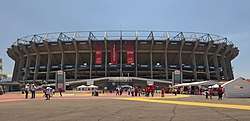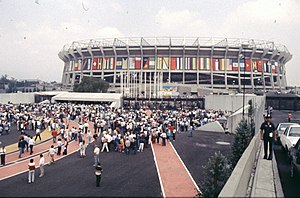Estadio Azteca
The Estadio Azteca (American Spanish: [esˈtaðjo asˈteka]) is a multi-purpose stadium located in Mexico City. It is the official home of football club Club América, Cruz Azul, and the Mexico national football team. The stadium sits at an altitude of 2,200 m (7,200 feet) above sea level.[5] With an official capacity of 87,523,[1] it is the largest stadium in Mexico. As of 2018, the stadium also serves as the home of Cruz Azul.[6] The National Football League (NFL) features one game at Estadio Azteca per season as a part of their International Series.
El Coloso de Santa Úrsula "The Colossus of Santa Úrsula" | |
 Stadium's exterior | |

| |
| Location | Tlalpan, Mexico City |
|---|---|
| Coordinates | 19°18′11″N 99°09′02″W |
| Public transit | |
| Owner | Grupo Televisa |
| Operator | Club América |
| Executive suites | 856 |
| Capacity | 87,523[1] |
| Record attendance | Football: 119,853 (Mexico vs Brazil, 7 July 1968)[2] Boxing: 132,247 (Julio César Chávez vs Greg Haugen, 20 February 1993)[3] |
| Field size | 105 m × 68 m (344 ft × 223 ft) |
| Surface | PlayMaster Hybrid Grass |
| Construction | |
| Broke ground | 1961 |
| Opened | 29 May 1966 |
| Renovated | 1986, 1999, 2013 and 2016[4](edit conflict) |
| Construction cost | MXN$260 million |
| Architect | Pedro Ramírez Vázquez |
| Tenants | |
| Club América (1966–present) Cruz Azul (1971–1996, 2018–present) Mexico national football team (1966–present) Necaxa (1966–1971, 1982–2003) Atlante (1966–1982, 1996–2001, 2004–2007) UNAM (1967–1969) Atlético Español (1971–1982) | |
Regarded as one of the most famous and iconic football stadiums in the world,[7][8][9][10][11] it is the first to have hosted two FIFA World Cup Finals;[12] in the 1970 World Cup Final, Brazil defeated Italy 4–1, and in the 1986 World Cup Final, Argentina defeated West Germany 3–2. It also hosted the 1986 quarter-final match between Argentina and England in which Diego Maradona scored both the "Hand of God goal" and the "Goal of the Century". The stadium also hosted the "Game of the Century", when Italy defeated West Germany 4–3 in extra time in one of the 1970 semifinal matches. Additionally, it is scheduled to host games in the 2026 FIFA World Cup.
The stadium was also the principal venue for the football tournament of the 1968 Summer Olympics[13] and 1971 Women's World Cup.[14]
History

The Estadio Azteca was designed by architects Pedro Ramírez Vázquez and Rafael Mijares Alcérreca and broke ground in 1961. The inaugural match was between Club América and Torino F.C. on 29 May 1966, with a capacity for 107,494 spectators. The first goal was scored by Brazilian Arlindo Dos Santos and the second one by Brazilian José Alves; later, the Italians tied the game, which ended in 2–2 draw. Mexican president Gustavo Díaz Ordaz made the initial kick and FIFA president Sir Stanley Rous was the witness.
A modern illumination system was inaugurated on 5 June 1966, with the first night game played between Spanish side Valencia C.F. and Necaxa. The first goal of the match was scored by Honduran José Cardona for Valencia. Roberto Martínez, aka Caña Brava, became the first Mexican to score a goal in the stadium after scoring for Necaxa. The result was a 3–1 victory for Valencia.
In 1978 the stadium hosted the final of the Copa Interamericana between América and Boca Juniors of Argentina, and would host a final again in 1990 between América and Club Olimpia of Paraguay.
.jpg)
The Estadio Azteca is also the site in which Pelé and Diego Maradona (during the 1970 and 1986 FIFA World Cup) lifted the trophy for the last time (The Jules Rimet Trophy and the current FIFA World Cup Trophy, respectively).
Estadio Azteca has also been used for musical performances throughout its history. Michael Jackson (5 sold-out shows in 1993),[15] U2 (in 2006 and 2011), Luis Miguel (in 2002), Elton John, Maná, Juan Gabriel, Gloria Estefan, Jaguares, Lenny Kravitz, *Nsync, Hanson, Ana Gabriel, and The Three Tenors all have become part of the stadium's main spectacle. The stadium has also been used for political events, including Mexican president Felipe Calderón's campaign closure in 2006, as well as religious events, such as Jehovah's Witnesses conventions, and the appearance of Pope John Paul II in 1999.[16]
In April 2017, it was announced that starting July 2018, Cruz Azul would relocate to the Azteca on a temporary basis, due to the impending demolition of the Estadio Azul. According to club owner Guillermo Álvarez, they plan on building a new private stadium, which could take an estimated three-to-four years.[6]
The stadium is scheduled to host games during the 2026 FIFA World Cup that will take place in the United States, Mexico and Canada. It will be the third time Azteca hosts World Cup games as the 1970 and 1986 games took place at the stadium. Additionally, it is currently vying for the inaugural game with SoFi Stadium in Los Angeles as another possible venue for the game.[17]
2015–19 renovation plans

The stadium has undergone gradual improvements and renovations, including the replacing of seating within the stadium as well as the installation of electronic advertising boards. In May 2015, modern Panasonic LED panels were installed at the north and south ends of the stadium, replacing the phosphorous panels installed in 1998.[18]
In February 2015, a vast renovation plan was unveiled with the intention that the completion of the project coincide with the stadium's 50th anniversary and with Club América's centenary in 2016, as well as the construction of a commercial hub outside the stadium to be completed some time in 2019. It was reported that Grupo Televisa, owners of the stadium, approved a joint-venture bid from private development firms IQ Real Estate and Alhel. The hub, named "Foro Azteca", would reportedly consist of a mall, office spaces, two hotels, new leisure spaces, and parking spaces for 2,500 cars.[4] The renovations to the stadium were planned in two phases: the first saw the demolition of the restaurant and seating at the lower east stand and the construction of a new hospitality area with dining and banqueting spaces, and the second saw the construction of new media boxes and private skyboxes at the upper west stand.[19] The renovations to the stadium were completed in November 2016.[20] The seating capacity was ultimately reduced to 87,000 as a result of the renovations.
Name

The name "Azteca" is a tribute to the Aztec heritage of Mexico City. The stadium is currently owned by Mexican multimedia conglomerate Televisa, which has a heated media rivalry with the similarly-named TV Azteca. Although there had been little to no confusion between the stadium and television network (which had only come into existence four years before in 1993), Televisa officially changed the stadium's name to Estadio Guillermo Cañedo on 20 January 1997, in tribute to Guillermo Cañedo de la Bárcena, a top network executive, former Mexican Football Federation president, and a prominent member of the FIFA executive committee who had died that day.[21] As with the similar situation with the defunct Candlestick Park in San Francisco in the United States and its sponsored names, few outside of Televisa itself took up the new name, and most of the general public probably had no thought about the stadium's ownership (much less the Televisa/Azteca rivalry) and continued to refer to the Estadio Azteca by its original (and current) name. After two of Cañedo's sons took a business interest in TV Azteca in 1998,[22] Televisa quietly returned to referring to it solely as Estadio Azteca.
Known colloquially by the nickname "Coloso de Santa Úrsula", which in English translates to "Colossus of Saint Ursula", due to its large structure and Santa Úrsula referring to the suburb where the stadium is located.[23]
Access and entrance
It is served by the Azteca station on the Xochimilco Light Rail line. This line is an extension of the Mexico City metro system which begins at Metro Tasqueña station and ends in the Xochimilco Light Rail Station.
Tickets are available up until kick-off times from the ticket office which is located at the front of the stadium, located towards the exit ramps from the Azteca station. Prices start from as little as MXN$100 (about US$5 as of 2016), and could cost up to MXN$500 (about US$26 as of 2016) for more high-profile matches.[24]
Monuments and memorials

A commemorative bronze plaque of the "Game of the Century" played between Italy and West Germany, as well as Diego Maradona's "Goal of the Century" against England.
There is also a commemorative plaque with the names of the first goal scorer in the inaugural match and in the first match played at night.
Notable events

Estadio Azteca has hosted a variety of international sporting competitions, including:
Association football
List of 1970 FIFA World Cup matches
| Date | Time (UTC−6) | Team #1 | Res. | Team #2 | Round | Attendance |
|---|---|---|---|---|---|---|
| 1970-05-31 | 12:00 | 0-0 | Group 1 | 107,160 | ||
| 1970-06-03 | 16:00 | 3-0 | Group 1 | 92,205 | ||
| 1970-06-06 | 16:00 | 4-1 | Group 1 | 95,261 | ||
| 1970-06-07 | 12:00 | 4-0 | Group 1 | 103,058 | ||
| 1970-06-10 | 16:00 | 2-0 | Group 1 | 89,979 | ||
| 1970-06-11 | 16:00 | 1-0 | Group 1 | 108,192 | ||
| 1970-06-14 | 12:00 | 0-1 | Quarter-finals | 26,085 | ||
| 1970-06-17 | 16:00 | 4-3 | Semi-finals | 102,444 | ||
| 1970-06-20 | 16:00 | 1-0 | 3rd place match | 104,403 | ||
| 1970-06-21 | 12:00 | 4-1 | Final | 107,412 |
List of 1986 FIFA World Cup matches
| Date | Time (UTC−6) | Team #1 | Res. | Team #2 | Round | Attendance |
|---|---|---|---|---|---|---|
| 1986-05-31 | 12:00 | 1-1 | Group A | 96,000 | ||
| 1986-06-03 | 12:00 | 2-1 | Group B | 110,000 | ||
| 1986-06-07 | 12:00 | 1-1 | Group B | 114,600 | ||
| 1986-06-11 | 12:00 | 1-0 | Group B | 103,763 | ||
| 1986-06-15 | 12:00 | 2-0 | Round of 16 | 114,560 | ||
| 1986-06-18 | 12:00 | 3-0 | Round of 16 | 98,728 | ||
| 1986-06-22 | 12:00 | 2-1 | Quarter-finals | 114,580 | ||
| 1986-06-25 | 16:00 | 2-0 | Semi-finals | 114,500 | ||
| 1986-06-29 | 12:00 | 2-3 | Final | 114,600 |
American football
- On 15 August 1994, Estadio Azteca hosted a preseason American Bowl game between the Houston Oilers and Dallas Cowboys which still holds the record for the highest attendance at any NFL game, with 112,376 in attendance.[27] The Houston Oilers won the game 6–0.
- On 2 October 2005, the first international regular-season game in the history of the NFL was played in the stadium between the San Francisco 49ers and the Arizona Cardinals. The game was a 31–14 victory for the Cardinals. It set the record of the largest crowd to attend a regular-season NFL game with 103,467, but this record would be broken in 2009.[27]
- On 21 November 2016, the Oakland Raiders hosted a home game along with the Houston Texans as part of the NFL International Series in the first game dubbed NFL Mexico Game. It was the first Monday Night Football game played outside the United States.[28] The game saw a sell-out crowd of 76,743 in a renovated Estadio Azteca.[29]
- On 19 November 2017, the Raiders hosted the Patriots at the stadium.[30]
- The Kansas City Chiefs were scheduled to play the Los Angeles Rams at the stadium on 19 November 2018.[31] However, due to poor field conditions brought on by recent events, as well as rain, the NFL cancelled the event and moved it to the Rams' home stadium Los Angeles Memorial Coliseum.[32]
- The Kansas City Chiefs played the Los Angeles Chargers on 18 November 2019, with the Chargers designated as the "home" team.[33]
| Date | Away Team | Result | Home Team | Attendance |
|---|---|---|---|---|
| 15 August 1994 | Houston Oilers | 6–0 | Dallas Cowboys | 112,376 |
| 17 August 1998 | New England Patriots | 21–3 | Dallas Cowboys | - |
| 19 August 2000 | Indianapolis Colts | 24–23 | Pittsburgh Steelers | - |
| 19 August 2001 | Oakland Raiders | 21–6 | Dallas Cowboys | - |
| 2 October 2005 | San Francisco 49ers | 14–31 | Arizona Cardinals | 103,467 |
| 21 November 2016 | Houston Texans | 20–27 | Oakland Raiders | 76,473 |
| 19 November 2017 | New England Patriots | 33–8 | Oakland Raiders | 77,357 |
| 19 November 2018 | Kansas City Chiefs | 51-54 | Los Angeles Rams | (moved to Los Angeles; poor field conditions) |
| 18 November 2019 | Kansas City Chiefs | 24-17 | Los Angeles Chargers | 76,252 |
Concerts
- On 12 March 1983, Menudo was the first band to sell out a solo concert at the stadium with an attendance of over 100,000 people.
- On 29, 31 October and 7, 9 and 11 November 1993, Michael Jackson finished the Dangerous World Tour with five sold out shows at this stadium, for a total of 500,000 people . (
- On 14 and 15 February 1997, Gloria Estefan performed at the stadium.
- On 16 June 2000, Los Temerarios performed at the Estadio Azteca for the first time in their career, in a sold out concert with the max of capacity, was over 87,000 people that attended. This concert was filmed in live.
- On 14 May 2011, Irish rock band U2 presented the 360° Tour scoring the most-attended concert on the tour with a total attendance of 110,000 people.
- On 8 May 2012, Paul McCartney performed at the Estadio Azteca for the first time in his career, in a non-sold-out concert for 53,000 people.[34]
- On 16 April 2016, Vicente Fernández played his farewell concert, titled "UN AZTECA EN EL AZTECA, ADIÓS A UN GRANDE", to a sell out crowd at the stadium with an attendance of over 100,000 people.
- On 11 and 12 October 2018, Shakira performed for around 200,000 fans with her El Dorado World Tour.
Christian events
- Nigerian Pastor T.B. Joshua held a two-day Christian crusade, attracting an estimated 150,000 over both days.[35]
- From 13 to 14 December 2013, assemblies were held by the Jehovah's Witnesses to commemorate their religious devotion with a series of performances in scenes of biblical passages, social-contemporary themes and Christian baptisms, of which each day record of participation of 105,000 faithful, of which on Sunday there was the record time of eviction of 10 minutes for reasons of other scheduled events and in turn 2000 participants were dedicated to cleaning after each event.[36][37]
Funeral services
- A public funeral service for popular Mexican comedian Roberto Gomez "Chespirito" Bolaños was held at Azteca on 30 November 2014, and was attended by 40,000 spectators. Chespirito had been a long-time supporter of Club América.[38][39]
See also
References
- "2026 FIFA World Cup Bid Book" (PDF). p. 161. Retrieved 5 April 2018.
- "El Monumental le gana a la Bombonera como estadio más emblemático". 12 April 2013. Archived from the original on 27 June 2013.
- "StadiumDB: Estadio Azteca". Retrieved 5 September 2013.
- "Historia #5". stadiumdb.com. Archived from the original on 25 March 2016. Retrieved 20 March 2016.
- Longman, Jeré (10 August 2009). "In Mexico, a Soccer Stadium Where Visitors Gasp". The New York Times. Retrieved 22 April 2017.
The massive bowl, Estadio Azteca, sits in the southern part of this sprawling metropolis like a concrete sombrero. The stadium’s mystique — especially its 105,000 spectators and its 7,200-foot altitude — will play an integral role Wednesday in a World Cup qualifying match between Mexico and the United States.
- "Mexico City: Cruz Azul to relocate to Azteca". StadiumDB. Retrieved 23 April 2017.
- "Ranking the Top 10 Most Iconic Stadiums in World Football". Bleacherreport. Retrieved 5 April 2013.
- "Classic Stadium: Estadio Azteca". FIFA.com.
- Smart, Tony. "10 of the world's best sports venues". CNN. Retrieved 9 March 2012.
- Mazur, Martin. "FourFourTwo's 100 Best Football Stadiums in the World: No.4". FourFourTwo. Retrieved 13 November 2015.
- Gordon, Aaron. "Mexico wins Mexican-American stadium war". Buzzfeed. Retrieved 9 April 2013.
- "Mexico's historical stadium". FIFA.com. Retrieved 31 May 2012.
- 1968 Summer Olympics official report. Volume 2. Part 1. pp. 78–79.
- In Danish ("The forgotten triumph, when Denmark won the World Cup")
- "Cronología Estadio Azteca". Archived from the original on 16 August 2007. Retrieved 13 September 2007.
- "Pide Juan Pablo II "superar" deficiencias en el progreso social". Retrieved 12 October 2007.
- "Azteca in plans to host 2026 opener - De Maria". ESPN.com. 13 June 2018. Retrieved 7 August 2019.
- "Panasonic's LED Large Screen Displays Provide an All-New Fan Experience at Estadio Azteca in Mexico City". Business Wire. Business Wire: A Berkshire Hathaway Company. 8 June 2015. Retrieved 28 July 2016.
- "Mexico: Azteca to lose capacity again". StadiumDB.com. 4 April 2016. Retrieved 28 July 2016.
- "El 'nuevo' Azteca" [The 'new' Azteca]. La Afición (in Spanish). Grupo Milenio. Retrieved 17 November 2016.
- "FIFA Senior Vice President Guillermo Cañedo has died". FIFA.com. 21 January 1997. Retrieved 11 October 2019.
- Martínez, César. "Cañedo Whites go to TV Azteca". La Jornada. Retrieved 13 September 2007.
- Rai, Asha (14 March 2014). "Estadio Azteca: Seasons in the Sun". The Times of India. Retrieved 17 March 2014.
- "Estadio Azteca". Stadium Guide.
- Agergaard, Sine; Tiesler, Nina Clara (21 August 2014). "Women, Soccer and Transnational Migration". Routledge – via Google Books.
- "Da Danmark blev verdensmestre i fodbold - TV - DR".
- "Cowboys set regular season attendance record". Pro Football Hall of Fame. 21 August 2009. Retrieved 14 July 2016.
- "Back to Mexico: Texans-Raiders to play Nov. 21 in Mexico City". NFL.com. 5 February 2016. Retrieved 6 February 2016.
- "Oakland Raiders Rally Past Houston Texans in Mexico City". New York Times. 22 November 2016. Retrieved 22 November 2016.
- Shook, Nick (18 November 2017). "What to watch for in Patriots-Raiders in Mexico". NFL.com. Retrieved 19 November 2017.
- "Chiefs-Rams to play in Mexico City next season". NFL.com.
- "NFL moves Rams-Chiefs from Mexico City to L.A." ESPN.com. Retrieved 13 November 2018.
- "NFL unveils dates, times for 2019 international games". NFL.com.
- Current Boxscore
- Elorriaga, Gerardo (7 June 2015). "El azote del maligno". Diario Sur (Spain).
- "Estadio Azteca rompe marca de desalojo". Testigos de Jehová-Jehovah's Witnesses (in Spanish). 15 December 2013. Retrieved 5 April 2018.
- "Testigos de Jehová limpian el Estadio". La Nación, Grupo Nación (in Spanish). Retrieved 5 April 2018.
- "Con un multitudinario funeral en el estadio Azteca, México despidió a Chespirito". losandes.com.ar (in Spanish). Retrieved 13 November 2018.
- "Remembering Roberto Gómez Bolaños". ESPN.com. Retrieved 13 November 2018.
Further reading
- "Magical memories live on in the vaunted Azteca" – fifaworldcup.com – FIFA
External links
| Wikimedia Commons has media related to Estadio Azteca. |
| Events and tenants | ||
|---|---|---|
| Preceded by National Stadium Tokyo |
Summer Olympics Men's football final 1968 |
Succeeded by Olympiastadion Munich |
| Preceded by Wembley Stadium London |
FIFA World Cup Opening venue 1970 |
Succeeded by Waldstadion Frankfurt |
| Preceded by Wembley Stadium London |
FIFA World Cup Final venue 1970 |
Succeeded by Olympiastadion Munich |
| Preceded by Camp Nou Barcelona |
FIFA World Cup Opening venue 1986 |
Succeeded by San Siro Milan |
| Preceded by Estadio Santiago Bernabéu Madrid |
FIFA World Cup Final venue 1986 |
Succeeded by Stadio Olimpico Rome |
| Preceded by Los Angeles Memorial Coliseum Los Angeles |
CONCACAF Gold Cup Final venue 1993 |
Succeeded by Los Angeles Memorial Coliseum Los Angeles |
| Preceded by King Fahd II Stadium Riyadh |
FIFA Confederations Cup Final venue 1999 |
Succeeded by International Stadium Yokohama Yokohama |
| Preceded by Rose Bowl Pasadena (Los Angeles) |
CONCACAF Gold Cup Final venue 2003 |
Succeeded by Giants Stadium East Rutherford (New York) |
| Preceded by first venue |
National Football League Host stadium of international regular season game San Francisco 49ers v. Arizona Cardinals 2 October 2005 |
Succeeded by Wembley Stadium, London, England New York Giants v. Miami Dolphins 28 October 2007 |
| Preceded by National Stadium Abuja |
FIFA U-17 World Cup Final venue 2011 |
Succeeded by Mohammed bin Zayed Stadium Abu Dhabi |


